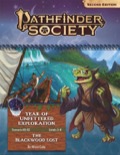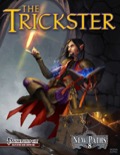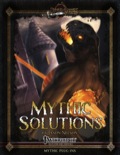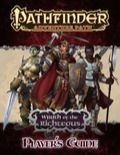|
Sign in to create or edit a product review. Great introduction to the adventure, even better if you played the previous Blackwood adventures (but not necessary to enjoy the whole). Engaging NPCs, a nice flow for the adventure alternating (and smartly linking) skill checks, combats and roleplay in a way far less standardized than usual, which is really good. New creatures for opponents, whose abilities you cannot always readily guess, so good value in RK. The fights did feel a little too easy, but then we did get some lucky crits a bit often. Not 5 stars (yet) because it seems the GM was missing a few info about the damage dealt by some hazard and about the last skill check.
Note that the check itself is incredibly well threaded with the rest of the whole adventure. This high consistency is one of the very best assets of this cool adventure. Kudos also for the sidequest. I thought it really well done too. Also, some part on a timer, interestingly done though we were not quite sure what would happen as it went down. All in all, an excellent time was had by everyone and I very strongly advise playing this. *** I updated my review to take into account the changes and many additions provided in the revised version of the pdf. These updates appear within asterisks, just like this one here *** The Trickster is a very elegant mix of Bard, Arcanist and Rogue with a suit of specialized abilities based on a Forte that is chosen among four possibilities, and a nod or two to the Arcane Trickster Prestige Class. *** Post Revision : there are now five Forte available, as well as an archetype that boosts them significantly *** It is a bit too far on the powerful side for me to consider it quite balanced though and the execution feels a bit odd at times. *** Post Revision : the overall package is still quite powerful, but the author included advice on nerfing it down. And the additional content (Shadow Forte, revision of the Acrobat Forte and dual-Forte archetype) means that this product now delivers incredible value for its meager price *** Let’s take a walk through the class. The presentation is fluid with only some hiccups (going from “he” to “they”, for example). The Trickster shares its basic chassis with the Bard : Hit die, skill points, proficiencies, spell slots per level and spells known (typo : should have been spells prepared, like the Arcanist). This last one being a mistake IMO, as I will detail further down. *** Post Revision : Skill points were downgraded somewhat because of the reviews, going to 4 skill points per level since the class is heavily INT based. I did not mind the previous 6 as the Trickster being a master of both Knowledges and Rogue skills fits the stereotype IMO. A minor change of low consequences that still reflects well on the author’s laudable ability to take criticism in stride and try and improve his creation *** Since the Bard is often compared to what a Rogue should be, using its chassis is a good choice to build the Trickster on. The Rogue (Core, not Unchained) brings it much of its class skills, sneak attack, trap sense, evasion, uncanny dodge (and improved), though these happen in a delayed fashion that brings a proper overall balance IMO. From the Arcanist, it gains the INT-based spellcasting mode (including access to the Wizard/Sorcerer spell-list), making the Trickster AFAIK the first ¾ BAB, 6-level caster using this powerful mode. Regrettably, the critical balancing factor of spells prepared / known is off, since it is based on the Bard’s values that are themselves balanced by the class-specific spell-list. Which is not the case for the Trickster. As a result, the Trickster actually gets MORE spells prepared than the Arcanist. It is only from 8-th level that the Arcanist will get more powerful through earlier access to high-level spells. That is the first step that pushes the Trickster on the too powerful side. *** Post Revision : To answer criticism on how powerful the class was, the author proposes to balance this by the option of making Necromancy and Evocation forbidden schools for the Trickster. I appreciate the effort, but I find the option provided lacking for 2 reasons : 1. It restricts the possibilities given to players for building their PC which is something I’d rather avoid. 2. It robs the Trickster of many spells which help him get the most of his Surprise Spells class feature. Evocation after all is THE school for HP damage. I would have preferred reducing the number of spells prepared at each level so that the Trickster ends up with less spells than the Arcanist. That said, once again, the author is willing to take into account criticism and change his creation accordingly and this is really something I applaud, even if the end result is a little subpar for my taste *** The Trickster is clearly to the Arcane Trickster what the Magus is to the Eldritch Knight : a base class declining the concept behind the Prestige Class in 20 levels. As such it incorporates signature abilities of the Arcane Trickster such as Ranged Legerdemain (though at 9th level, where an Arcane Trickster could get it as a 6th-level character) and Surprise Spells (at 15th level, same character level at which an Arcane Trickster could get it). Nothing unbalancing here. In fact I am not sure why Ranged Legerdemain appears so late. The Trickster also gains bonus feats selected from a small list mixing Rogue and Wizard’s flavors. I am not sure why the author put these in, maybe to compensate for the absence of rogue Talents, but they do feel both tacked onto the chassis and adding too many goodies to what is already a strong class. Or maybe they were just put there to avoid empty levels, which I would then see as uninspired design. In all honesty, I would get rid of them without blinking an eye. These bonus feats are the second step in giving this class a bit too much. The special abilities are IMO what gives a class its singular identity, especially for a 3pp one. And here the author delivers both adequate value and a satisfying take on the magical Rogue concept. The first Trickster-specific class feature is the choice of one of four Fortes at 2nd level. This choice is exclusive, which mostly begs for feats that would allow a Trickster to pick abilities from a Forte he did not choose. The Fortes feel odd to me because I think they should have been treated as a single class with 3 archetypes. As is, adding archetypes will be in addition to the Forte choice and these last features will not be changeable, which is needlessly limiting further design options IMO. I do not know why this design option was chosen, but I feel that it might have been a matter of wordcount. Each Forte explores a theme of the Rogue and how magic can improve it. Which means we need more Forte exploring other themes of the magical Rogue. Paradoxically, the Forte do this better than an archetype would because they are focused on a small set of related abilities. So, in the end, while I believe that base class + archetypes would have been a better design choice, I do not count it against the product’s final rating. I definitely think a Forte about shadow and one focused on sniping are lacking though. *** Post Revision : There is now a fifth Forte about Shadow : ask and you will be answered by Marc Radle !!! And that at no additional price. See further down my assessment of this addition to the class’ possibilities *** A Forte gives its basic ability at 2nd level, an improved one at 5th level and the last one at 9th level. Note that this makes the 5th level (where the Trickster also gets Sneakspell) and 9th level (where he also gets Ranged Legerdemain) levels of plenty in the Trickster’s ability progression. I must say that I would have preferred a more continuous increase. The four Fortes we get here are slightly mismatched in power level. The Acrobat : the tumbling Rogue theme. I believe these abilities should be Rogue Talents or some Rogue archetype. There is not enough magic here to fit the Trickster concept IMO. *** Post Revision : The Acrobat Forte got magic alright. I think it even became one of the strongest Forte what with increasing base speed, gaining the previous 9th level powers as soon as 5th level (with additional increase to AC later on) as well as a freedom of movement effect and a dimension door one (a bit strange wording on that one but it may be the official parlance for such effects) *** The Arcane Accomplice : the flanking Rogue theme, served by getting a familiar with its own sneak attack. d4 instead of d6 for damage is not enough IMO to prevent this from being abused. Maybe restricting it to apply only when attacking the same target as its master, or when flanking would have struck a better balance. But I am not enough of a designer to assess this properly. The way its is done here, it is a bit powerful, but not devastatingly so. The next Forte is the Beguile. Among the four Fortes, the Beguile feels the most like what could have been the main class : the casting Rogue theme. Spells more efficient against a target denied its DEX bonus is one of the archetypical ability people look for in such a casting Rogue class. Increasing the power of Feint to reasonable levels works quite well too. Great job here. The Spellpilfer : The spell stealing Rogue theme. You temporarily steal a spell from your target’s list and add it to your own. Great building on the theme of spell stealing that is also the basis for the Filch Spell ability (see below). Excellent mechanics, and the short time limit keeps this to a reasonable power level. Note however that this could be mildly abused by targeting allies with it, as they will voluntarily fail their save against this ability, that is if they do not mind becoming a battery for your spellcasting knowledge. Also this Forte hinges on INT and thus makes the Trickster more SAD than the other ones, which can also lead to characters that are a bit too powerful. *** Post Revision : The Shadow Forte : the stealthy Rogue theme with some HiPS ability that sounds like that of the shadowdancer, as well as bonuses dealing with/against shadow and darkness spells as well as seeing in any darkness (eventually). That looks pretty strong *** Other than the Forte, several abilities are also completely new to the Trickster : At 5th level, Sneakspell adds a touch spell to a sneak attack, in a way similar to the Magus’ Spellstrike. Missing makes you lose the spell however. Improved Sneakspell lets you keep the charge but happens at a level high enough (17th) that it does not become unbalancing. At 14th level, Filch Spell allows the Trickster to steal the control of a spell for one round. It is well crafted and thematically on spot. So much so in fact that I would not have minded the Trickster gaining it earlier, maybe with a standard action at first, then going to move then swift, similar to the improving action cost of starting a Bardic Performance. The capstone of the class is solid but unimaginative, as it makes sneak attacks and sneakspells markedly deadlier but it is a mere power increase (and one that kind of comes out of the blue rather than being the culmination of previous abilities), so no bonus point for out of the box creativity there. Finally, since this base class is clearly inspired by the Arcane Trickster Prestige Class, how do they fit together ? Going into Arcane Trickster from Trickster is pretty straightforward since you meet all requirements with 5 levels in Trickster. I would advise waiting for the 6th level in Trickster, that gains you +1 to BAB and to all Saves, as well as a bonus feat before going into Arcane Trickster. Now why would you do this ? Well, the Arcane Trickster gains sneak attack faster and has a few specific goodies (Impromptu Sneak Attack, Tricky Spells and Invisible Thief), whereas the Trickster will strengthen his Forte, gain the Uncanny Dodge chain as well as the best signature abilities of the class : Improved Sneakspell and Filch Spell. In the end, considering that I can find more ways to replicate the Arcane Trickster’s abilities (with feats, spells, items) and that I think them a little weaker, I would stick to Trickster. *** Post Revision : Dual Forte Archetype. If you thought Forte were strong, this archetype just takes them over the top. Not only do you gain a second Forte (though functioning at a reduced Trickster level), but your first Forte gains extra abilities at higher level that just bring it to the OMG (though not completely broken) power level. I do not expect those who wish for a more balanced Trickster to look kindly on these. To get this, you sacrifice the bonus feats (sign me in), Improved uncanny dodge (ok by me), as well as filch spell (Take me now. I am ready). As a GM, I would split this archetype in two mutually exclusive ones (that replace the same features mentioned above) : one that gets the second Forte, and another one that improves the first Forte. YMMV of course *** CONCLUSION
The Trickster is a very good class that will definitely appeal to those who appreciate the Rogue’s theme but feel that the Core (or even Unchained) Rogue is woefully underpowered in comparison to other classes.
Still I think that would be best done by its designer and should not be left to the product’s buyers. Because of this and the hiccups in design I mentioned above, I cannot in good faith give this product its 5th star, even though I dearly wish to, if only because it definitely answers a need that went unsatisfied for far too long. You did a very good job here, Marc. Almost perfect actually and it proved agonizing to choose between 4 and 5 stars for the Trickster. Please, keep providing us with your simple and elegant classes *** Post Revision : Yes, the Trickster is still too powerful IMO, and I do not like the proposed balancing mechanism. And the new archetype makes it even more powerful. Yet, all this additional material means I am not agonizing about this product's rating anymore. This pdf contains incredible value at a small price and the changes needed to tone it down are easily made. It entirely deserves its 5th star. And as a free bonus, Marc Radle shows what being a class act author is all about, willing to go the many extra miles to add value to his creation by listening to its audience's feedback. Even if you fear that this class is too powerful, BUY THIS NOW and adjust it to your heart's content *** I backed the Mythic kickstarter. While I was perusing the draft of the Mythic Hero's Handbook looking for typos, I happened upon a part of the book I did not know about. It was describing different ways to keep Mythic rules under control while staying true to their objectives of making your PCs true legends. That was exactly the grail I was looking for after perusing so many threads lamenting all that was broken in Mythic Adventures, trying to find a way to add it to my campaign without being overwhelmed. This part in itself was enough for me to justify being a backer. And this is what you get here. I can't believe the boards monster ate my lengthy and detailed and well-argumented first review :-( To sum it up, too little text spent on character tips (and some of them actually not needed), too much ads for other books, too much reuse of other books sometimes also not needed in a Player's Guide (redemption, metagame demon hunting). Not enough for building characters deeply ingrained/motivated in the setting. Problematic campaign traits that are a big unknown even to the GM at this stage and that are VERY strongly advised to take (with many constraints to boot). Having paid for all the other books that see reuse in this free product, I only give it a single star. If I had not bought these other books, I would likely give it at least 2 stars. |








